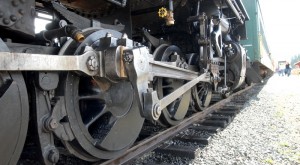 In high anticipation, we gathered at the Mt. Rainier Scenic Railroad depot (MRSR) in Elbe, Washington. With a mournful whistle, the train, consisting of a steam engine pulling four cars, click-clacked its way toward us.
In high anticipation, we gathered at the Mt. Rainier Scenic Railroad depot (MRSR) in Elbe, Washington. With a mournful whistle, the train, consisting of a steam engine pulling four cars, click-clacked its way toward us.
The longest continuously operating steam train in the Northwest, the Mt. Rainier Scenic Railroad is a big attraction to this tiny town. Elbe, established by German immigrants in the late 1800’s, was named after the Elbe River Valley near Hamburg, Germany. The town is also known for its famous historical Lutheran church, Evangelische Lutherische Kirche.
We had our choice of seating and our family of six adults chose the last of four cars which happened to have windows with no glass, the better choice to hang out to take pictures. Some cars had glass windows. We sat on bench seats; the car before us had tables, much like a dining car.
Bill, our conductor, made his career on trains for 41 years and in his retirement volunteers with MRSR. He coached us to signal the engineer that it was safe to move the train forward, a signal known as “High Ball” followed by the train’s engine number. Together we yelled “High Ball 17!” and the train’s whistle immediately responded. With a blast of steam, we were on our way.
A train’s whistle, originally referred to as a steam trumpet, is an efficient means of non-verbal communication and each cadence has its own meaning. One whistle indicates the train is ready to go. When we passed a crossing, we heard two long, one short, one long cadence, other times it blew in greeting as we passed various landmarks. The gentle swaying of our bench seats and the nostalgic whistle made me think of what traveling one hundred years ago must have been like. Sitting by the window, I often felt the spray of steam condensation.
The train’s maximum speed is about 10 miles per hour giving us plenty of time to view a few back yards, then wide open space with grazing cattle and horses, meadows, a spectacular beaver dam, and mountain streams cloudy with glacier runoff. At one point we were on a trestle, high in the air.
As we climbed a grade, our sturdy little train chugged what sounded to me like, “I think I can, I think I can.” As we traveled Mount Rainier’s forests and foothills in October, we viewed fall’s colorful changing leaves, mixed with brilliant green conifers. At one point, as we crossed the Upper Nisqually River, we got a peek of the great mountain, its top capped with clouds.
We pulled into the small unincorporated community of Mineral for a scheduled museum visit. Mineral originally began as a mining town, then turned into a logging camp and sawmill, neither of which are currently in operation. Today Mineral claims to have the most comprehensive collection of steam logging locomotives in the world. The excursion schedule allows 45 minutes to visit the various exhibits which include individual buildings: Railroad Logging Camp, House of Gears, Rod House and Restoration Shop. A gift shop has railroad memorabilia, and a small concession has light snacks and beverages. Some people brought lunches and sat at picnic tables situated throughout the railroad camp.
When our conductor Bill learned I was a writer, he invited my husband Bruce and me to visit Engine 17’s cab. It was a high step up, plus three more steps to a space filled with boilers and the machinery needed to pull the train. A blast of heat–about 110 degrees–made me appreciate the work of an engineer. We were told that on a hot day the engine cab can climb to 140 degrees. No wonder we often see an engineer leaning out a window! A two-foot wide walkway the width of the train gave access to two pressure gauges and about 30 valve handles. Rather than wood or coal used in the old days, this steam engine is fueled by diesel and a large fuel tank is also in the engine cab. There are no ready-made parts for this American Locomotive Company Engine 17, originally built in 1929. In its renovation, all parts had to be machined from scratch out of blocks of steel. The rebuilt engine has been in use for about 1500 hours.
The MRSR excursion takes about two hours. We rounded out our day with a late lunch at the Mount Rainier Railroad Dining Company, an old train which has been turned into an Elbe restaurant. We enjoyed our meal and our group of six had a dining room to ourselves.
For more information about the Mt. Rainier Scenic Railroad and Museum, visit www.MRSR.com or call (360) 569-7959.

